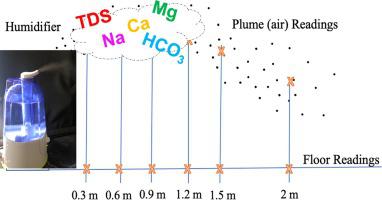Environment International ( IF 11.8 ) Pub Date : 2020-07-02 , DOI: 10.1016/j.envint.2020.105902 Wenchuo Yao 1 , Rachael Dal Porto 2 , Daniel L Gallagher 1 , Andrea M Dietrich 1

|
Ultrasonic humidifiers provide indoor relief to symptoms caused by dry air and produce aerosols containing both water and minerals that are present in the water that fills the humidifier. This study investigated the spatial distributions, concentrations, and metal and mineral composition of aerosols emitted when an ultrasonic humidifier was filled with deionized water (DI), low mineral tap water (LL), high total dissolved solids (TDS)/high hardness water (HH), and high TDS/low hardness water (HL). Aerosol/particle sizes and counts were obtained at six horizontal distances in both the plume and near floor for each water quality. Results are that water quality significantly affects particle size distributions which become uniform after 0.9 m from the humidifier outlet, and are independent of vertical distance from the humidifier. The mean count median diameters were 64 nm for DI, 129 nm for LL, 234 nm for HH, and 260 nm for HL; the particle counts and total mineral solids concentrations were 2,194 #/cm3 (16 µg/m3) for DI, 21,070 #/cm3 (113 µg/m3) for LL, 38,353 #/cm3 (438 µg/m3) for HH, and 43,880 #/cm3 (521 µg/m3) for HL. The µg/m3 values for LL, HH, and HL exceeded PM2.5 ambient air standards. Model predictions are that the deposition mass in the human respiratory system from inhaling particles emitted from HH and HL water exceed 135 µg for a 1 to 3-month old child and 600 µg for an adult over an 8-hr period. Mineral water quality significantly affects the distribution and concentration of emitted and inhaled indoor air particles. Consumers may unknowingly be degrading their indoor air quality when using tap water of acceptable drinking water quality as humidifier fill water.
中文翻译:

人体在空气-水界面处的颗粒暴露:使用超声波加湿器对水质对室内空气质量的影响。
超声波加湿器可缓解室内干燥空气引起的症状,并产生包含水和填充加湿器水中的矿物质的气溶胶。这项研究调查了当超声加湿器中充满去离子水(DI),低矿物质自来水(LL),高总溶解固体(TDS)/高硬度水时,散发的气溶胶的空间分布,浓度以及金属和矿物成分。 HH)和高TDS /低硬度水(HL)。对于每种水质,在羽流和近地面的六个水平距离处均获得了气溶胶/颗粒尺寸和计数。结果表明,水质会显着影响粒径分布,该粒径分布在距加湿器出口0.9 m后变得均匀,并且与距加湿器的垂直距离无关。DI的平均计数中值直径为64 nm,LL为129 nm,HH为234 nm,HL为260 nm。颗粒数和总矿物固体浓度为2,194#/ cmDI为3(16 µg / m 3),LL为21,070#/ cm 3(113 µg / m 3),HH为38,353#/ cm 3(438 µg / m 3),43,880#/ cm 3(521 µg) / m 3)。LL,HH和HL的µg / m 3值超过PM 2.5环境空气标准。模型预测是,在1到3个月大的儿童中,吸入HH和HL水排放的颗粒在人体呼吸系统中的沉积质量超过135 µg,在8小时内对于成人超过600 µg。矿泉水的质量显着影响排放和吸入的室内空气颗粒的分布和浓度。当使用饮用水质量合格的自来水作为加湿器填充水时,消费者可能会在不知不觉中降低室内空气质量。



























 京公网安备 11010802027423号
京公网安备 11010802027423号